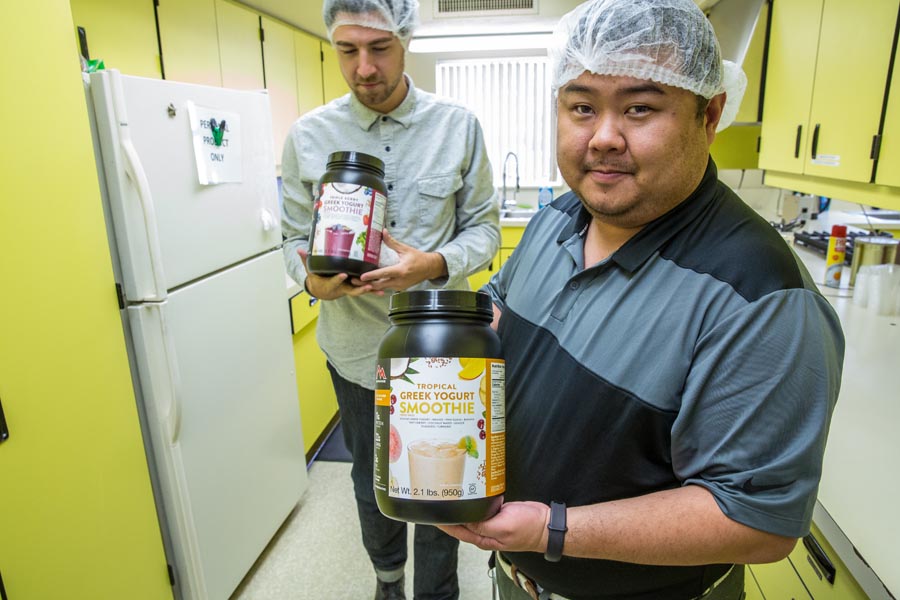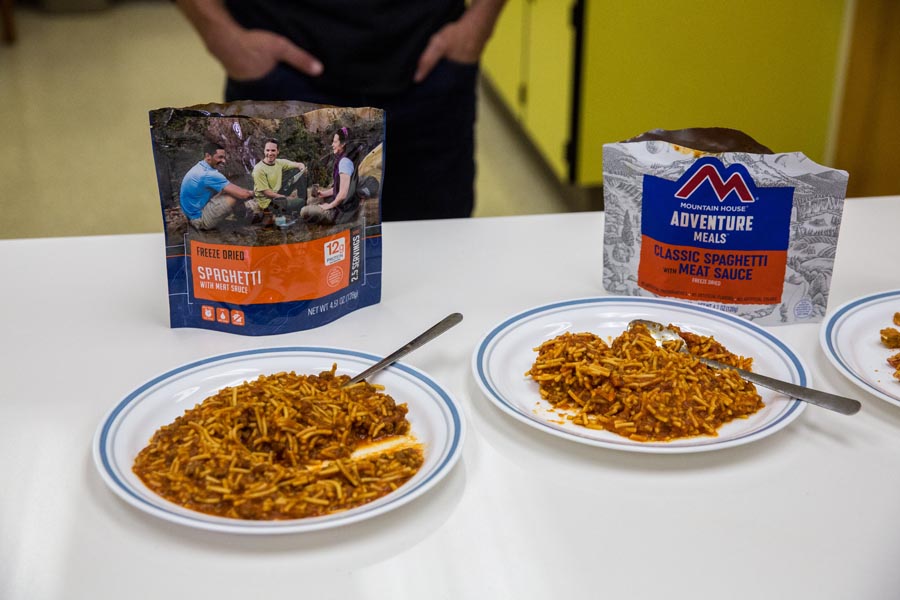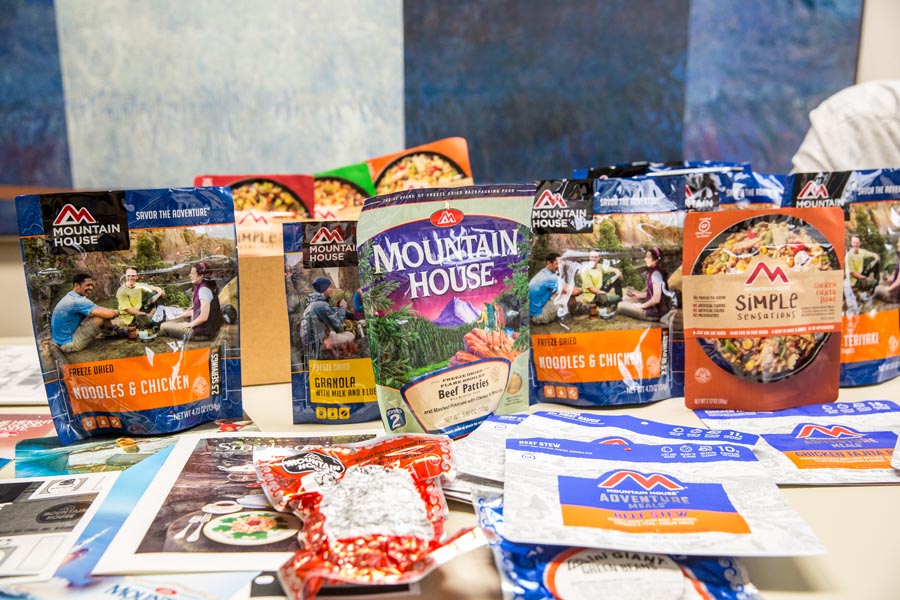OFD Foods expands its well-known freeze-dried meal pouches to cater to young, busy professionals.
Any hiker or hunter who has added hot water to make a meal in the woods probably has enjoyed a little something from OFD Foods.
The company occupies a specialized niche in preserving food and other perishable products. Better known as Oregon Freeze Dry, OFD Foods practically invented the outdoor adventure food category.
Its Mountain House brand turned 50 years old this year and still dominates 70% of the market catering to campers. Its meal pouches can be found on shelves near tents and sleeping bags in most large outdoor retailers in the U.S. and Canada, including REI, where the brand got its start.
But now OFD Foods is pivoting on its patented freeze-dry technology platform. In a new strategic push, it is relaunching its core Mountain House line and expanding new brands of foods into grocery aisles, pharmacy store chains and sports locker rooms.
And the company has even bigger plans. It may soon be in a position to carve out its most ambitious vision: creating innovative foods to manage chronic disease. The company is not sharing details yet, but its recent brand updates and new brand rollouts are early steps toward developing and marketing more functional foods, delivering lifestyle and health solutions.
In January Mountain House meals will look and taste a little different. New packaging will feature a “clean label.” That’s industry jargon for a list of wholesome-sounding ingredients with no unpronounceable preservatives and no genetically modified items.
It has taken three years to reformulate, test and prepare to relaunch its legacy meals, such as spaghetti with meat sauce. More adventurous recipes have been added, such as vegetarian yellow curry and pad thai.
Beyond updating recipes for the foodie camouflage crowd, the company has set its sights on time-stressed commuters. In the past few months, OFD Foods launched a new brand called Simple Sensations.
The 250-calorie, single-serving pouches are designed for young professionals between 25 and 39 years old who juggle hectic schedules of work, working out and running kids around.
In Oregon and two other western states, people may find Italian pepper steak and chicken fajita bowl instant meals next to the boxed mac ’n’ cheese at Safeway and Market of Choice. Nationwide, the meals will be in 900 CVS stores and online at Amazon.
 In the bright-yellow test kitchen, OFD’s marketing team displays the freeze-dried smoothies in two flavors: triple berry (left, in hands of Zac Gilliland) and tropical (right, Joshua Wark).
In the bright-yellow test kitchen, OFD’s marketing team displays the freeze-dried smoothies in two flavors: triple berry (left, in hands of Zac Gilliland) and tropical (right, Joshua Wark).
The company also created a performance product for athletes: smoothies freeze-dried from a blend of Greek yogurt, fruits and other ingredients — such as sour cherry, turmeric and ginger, which “have emerging science around their anti-inflammatory properties” to aid in athletic recovery, says Jeni Billups, senior vice president of marketing and sales.
The smoothies are packaged in team-sized tubs and are marketed directly to college and professional sports teams. And yes, the yogurt’s probiotic bacteria come back to life when water is added.
“We’re just closing out an era of the company when we were focused on ‘What can we freeze dry?’ and ‘How can we keep our chambers full?’” Billups says.
“We’ve shifted focus more toward the brand. We’re getting more consumer focused and learning what consumers want. These things were always in the background. Our mission today is enhancing lives. That applies to our products and living in our community.”
 Out with the old (left) and in with the new (right): The reformulated recipe for spaghetti with meat sauce adds tiny diced tomatoes.
Out with the old (left) and in with the new (right): The reformulated recipe for spaghetti with meat sauce adds tiny diced tomatoes.
OFD Foods occupies 35 acres on two sites straddling the railroad tracks in Albany, Oregon. It employs more than 400 people and runs three manufacturing plants with USDA and FDA registrations covering food, nutritional supplements such as probiotics, and pharmaceuticals.
Collectively, these plants represent 32,000 square feet of freeze-drying capacity.
The firm maintains a low-key presence in its hometown. Ask people who live in the area, and if they recognize the company name, it’s mostly from its charitable support in the community.
Amtrak riders might notice a Mountain House brand logo on an otherwise anonymous big-box building bordering the tracks near the train station. The campus contains two other specialized processing facilities and the mountain-shaped, glass-fronted OFD Foods corporate headquarters.
OFD Foods got its start in 1963, when two engineers from food giant General Foods Corp left with a deal to supply freeze-dried strawberries for Post cereal Corn Flakes. Albany, Oregon, offered low-cost hydroelectric power, economic incentives and plenty of strawberries in nearby fields.
The founders designed and built a freeze-drying facility that the company has been refining and expanding ever since. Soon the company found a commodity niche, freeze-drying corn, peas, shrimp, eggs, beef and chicken for the ramen-noodle industry and others.
Then came the Vietnam war.
Ready-to-eat rations and canned food were too heavy for special forces to carry through the jungle. The military sought other options, such as light freeze-dried meals. Founder Ellis Byer asked his wife, Norma, to cook a recipe to military specifications. Byer took the meal to work and freeze-dried it, using a clothing iron to seal the package.
It worked, securing OFD Foods a $6 million military contract. “It was a big turning point for the company,” says CEO Jim Merryman. “We added facilities for cooking and packaging.”
Then came the birth of Mountain House. In November 1967, Newsweek magazine ran an article about the surprising rave reviews of the freeze-dried meals from troops, who couldn’t find them when they returned stateside. “The only better chow we could possibly get would be Mom’s home cooking,” the article quoted one sergeant.
 Mountain House is relaunching its brand (empty packets, right)
Mountain House is relaunching its brand (empty packets, right)
Only 13 days later, Lloyd Anderson, a founder of Seattle-based REI, sent a short typed letter to Byer asking for their prices. “Long story short, we created a retail brand, based off those meals we did for the military,” Merryman says. OFD Foods still has the original copy of the letter.
The company’s fortune changed when Byer had a second heart attack and decided to get out of the business. He sold OFD Foods to the 7-Up company just months before Philip Morris bought 7-Up.
Philip Morris moved Herb Aschkenasy, president of its chemical division, to Oregon. Aschkenasy later led OFD’s management team in purchasing back the company when Philip Morris was shopping for a new buyer in 1986. Aschkenasy headed the company until his death in 2012, but he had planned for Merryman to succeed him.
During the Aschkenasy era, the company explored far-flung realms of freeze-drying. It refined techniques and technologies, working with more than 400 different food items. Those items built company expertise, but most never made it farther than the test kitchen.
For example, “we can do wonderful ribeye steaks,” says Walt Pebley, vice president of technical innovation at OFD Foods. “If we freeze-dried a steak and put it on the grill, you wouldn’t know if it was fresh or rehydrated.”
Other fatty foods are more difficult. “You won’t have freeze-dried butter,” Pebley says.
As the freeze-dried commodity business moved overseas to less expensive processors, the company diversified, adding a second facility to freeze-dry probiotics in the 1980s and a third to freeze-dry medical devices in the 1990s.
Along the way, it conducted contract research on a staggering variety of substances. For NASA, it experimented with rocket fuel that, in a freeze-dried form, could be made more stable and lighter, say, for a mission to Mars. It developed a unique propellant for Ford F-150 airbags.
“If we freeze-dried a steak and put it on the grill, you wouldn’t know if it was fresh or rehydrated.” Walt Pebley, vice president of technical innovation at OFD Foods
For the military, it developed flexible wound-healing pads made from a medicated hydrogel scaffold, as well as blood platelets that can be hydrated and deployed to stop internal hemorrhaging in battle zones. In an agricultural application, it developed a way to freeze-dry bacteria that can protect seeds and help them germinate.
The company has a diverse portfolio that buffers the ups and downs of different market segments, but a large expansion funded by venture-capital investment has stalled due to the U.S.-driven trade wars.
Less than a year after OFD Foods opened a new facility in upstate New York, it suspended operations and laid people off. The factory was built to supply probiotics to one large customer, which lost its international market. Merryman is optimistic that OFD Foods customers will regain their overseas customers.
The company hopes the addition of new branded lines will help give it more control over its future, Billups says. One of the challenges in revamping its traditional recipes was its supply chain. OFD Foods was remaking recipes without preservatives, but the company is small potatoes for most of the companies that supply such ingredients, she says.
Its freeze-dried food now can survive decades in the company’s water-tight packaging, making it a staple of many disaster-preparedness kits. That means it could take decades for some of the company’s longtime customers to taste the updates.
Photos by Jason E. Kaplan
To subscribe to Oregon Business, click here.





